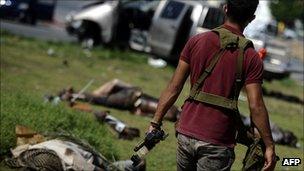Libya: 'Mass killing' sites in Tripoli
- Published
Evidence emerging from Libya suggests that several mass killings were carried out as rebel forces swept into the capital Tripoli earlier this month.
BBC correspondents have visited sites where large numbers of bodies have been found, and medical workers and rights group are gathering evidence which could be used in future war crimes trials.
Here are some of the main discoveries around the city so far.
.jpg)
Warehouse in Khalida Ferjan, Salahaddin
At least 47 bodies have been found at the site of the warehouse in a suburb to the south of Tripoli. The building was being used as a temporary prison by the Khamis Brigade, the elite force headed by Col Gaddafi's son. Human Rights Watch described the killings as "merciless murders".
Witnesses told HRW, external the prison guards had opened fire on the inmates on 23 August, as rebels were battling pro-Gaddafi troops for control of Tripoli. They said the guards fired through the sheet metal roof of the building onto inmates and threw grenades towards them.
Many of the bodies were charred beyond recognition, but it remains unclear how the fire started.
One survivor, Abdulrahim Ibrahim Bashir, said 153 detainees had been in the prison at the time and that only about 20 escaped. He said most of those interned were civilians.
Gargur district
Rupert Wingfield-Hayes reports from one of Tripoli's main hospitals in the Mitiga District
Human Rights Watch says it has evidence, external which suggests at least 17 people were shot dead by pro-Gaddafi troops on about 21 August, as the rebels advanced on the Gargur district of Tripoli.
Those killed were said to have been held prisoner at an Internal Security building in the district. They were tortured before being killed.
A British doctor at the hospital told the BBC about half the bodies had gunshot wounds to the back of the head and many had disfiguring injuries.
HRW says another two bodies were found at the site later, in a cupboard under the stairs. Witnesses had told the group two men were killed shortly before the apparent massacre.
Site between Gargur and Bab al-Aziziya
On 26 August, on a dry river bed between Gargur district and Col Gaddafi's compound of Bab al-Aziziya, HRW workers found the bodies of 18 people who had apparently been killed during the previous week.
HRW's report suggests the site was used as a body dump by Gaddafi loyalists over a period of several days. Several witnesses told the organisation that two doctors had been pulled out of an ambulance nearby, along with their driver, by men in military uniforms.
Two of the bodies were wearing green surgical scrubs when they were found.
Camp outside Bab al-Aziziya

At least 29 bodies were found on 25 August on a patch of ground just outside Col Gaddafi's Bab al-Aziziya compound in central Tripoli - the area appeared to be a makeshift clinic, on the site of what had been a pro-Gaddafi camp.
Some of the dead men were wearing green bandannas or strips of cloth, suggesting they were Gaddafi loyalists. At least two of the bodies were reported to have had their hands tied behind their backs. HRW said one had a bullet-wound to the head.
HRW said four bodies had been found on beds inside the clinic while others were on cushions and the floor nearby. There were reports that one corpse had an intravenous drip connected to an arm.
It is not yet known whether the killings were carried out by rebel fighters or other pro-Gaddafi troops. Sidney Kwiram, a HRW worker who went to inspect the site, told the BBC on 26 August that while earlier discoveries of mass killings "exclusively" implicated pro-Gaddafi troops, no such view could immediately be made of the Bab al-Aziziya site.
Abu Salim hospital
It remains unclear quite what happened at the Abu Salim hospital, where the bodies of more than 200 men, women and children were found, lying on the floor in corridors, on trolleys or in their beds.
Some local people have accused the pro-Gaddafi forces of killing, but Red Cross spokesman Robin Waudo told the BBC that the hospital had found itself on the front line of the fighting, and that in the heat of battle, doctors and staff were simply unable to reach it.
The Red Cross has evacuated 17 patients to another clinic and is attempting to restart work at the hospital. It has described what happened there as shocking.
"Parties to the conflict must protect wounded people and ensure they have access to health care," said a spokesman. "If a medical facility is located in an area heavily affected by fighting, the wounded need to be taken quickly to a safer place to receive urgent treatment."